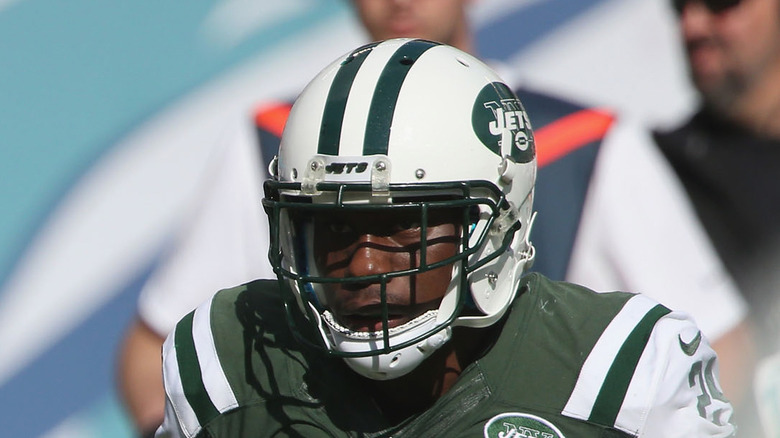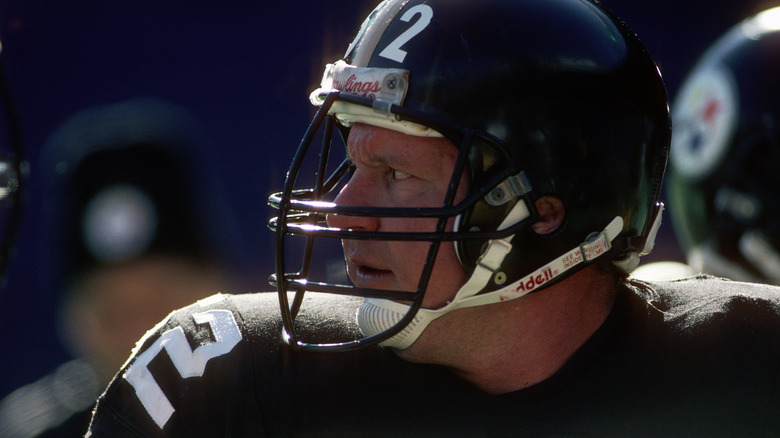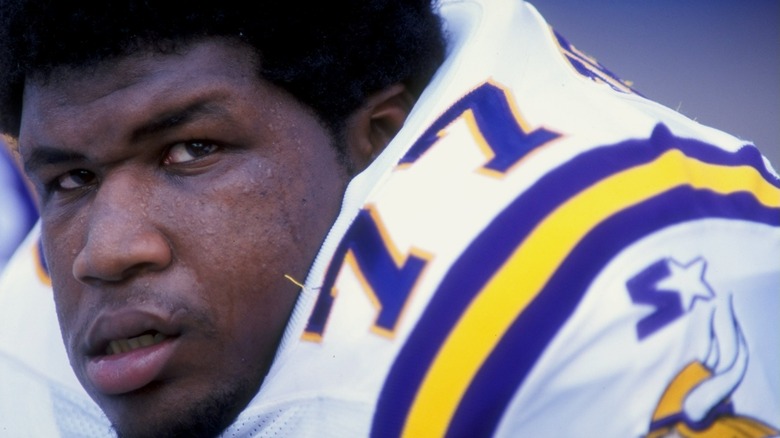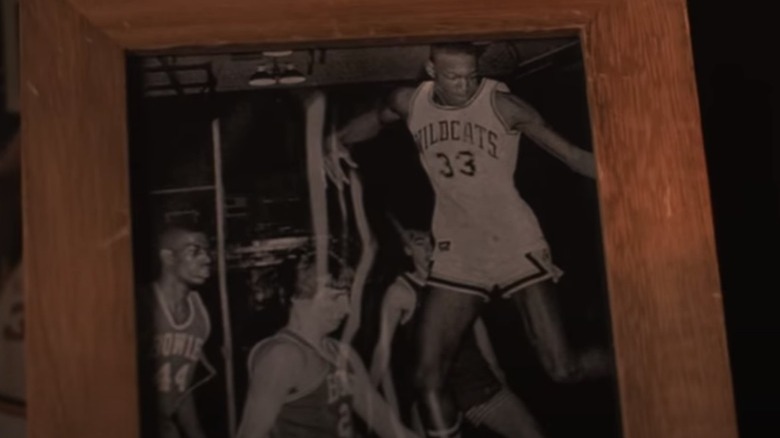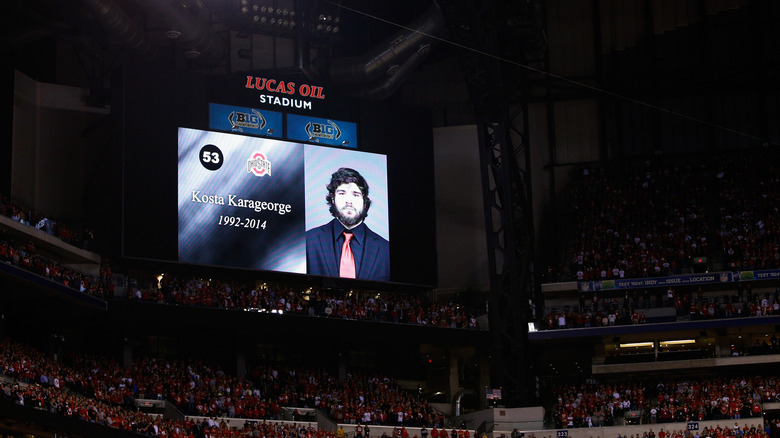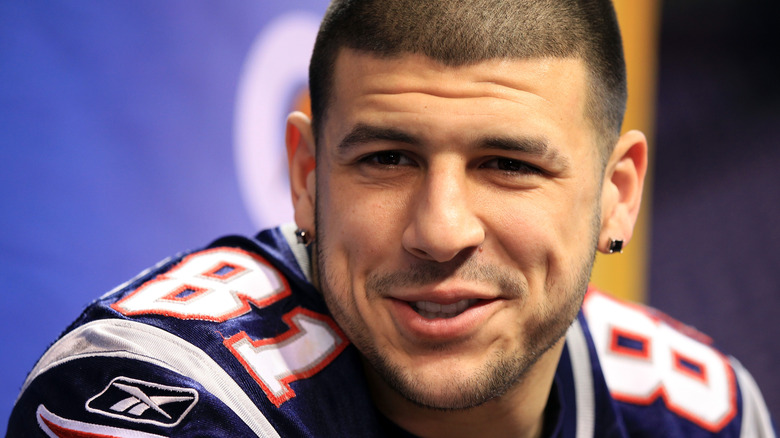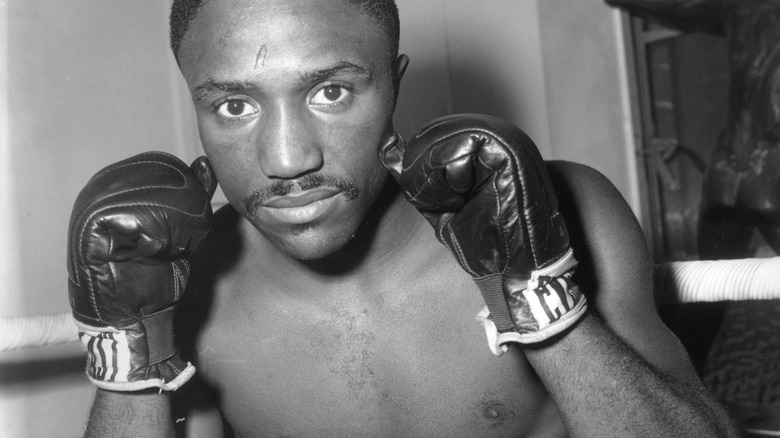Disturbing Discoveries Found In Famous Athlete Autopsy Reports
We usually think of professional athletes as being at the very peak of physical condition. While they are, they also push themselves way beyond the limits most people are capable of hitting. The wear and tear they subject themselves to for the entertainment of the masses, the enjoyment of the game, and in the pursuit of (sometimes) some serious cash can cause a lifetime of problems.
That's something that tends to get overlooked a bit, at least, in the heat of the moment and in the middle of the game, when all those hits, strains, and tears just keep on coming. When these athletes pass away, sometimes it's shocking stuff.
The first autopsy was famously performed on Julius Caesar after his assassination, and the findings pushed Rome to the brink of chaos. Since then, autopsies have been giving us a glimpse into the inner workings of the human body — and why it fails. It's also been giving us the answer we ask when family, friends, and idols die: Why? Sometimes, we don't like the answer.
Mike Webster
Mike Webster was the center for the Pittsburgh Steelers in the 1970s, including the '75 Steelers team, but there was no coaching position, charity events, or broadcasting jobs in his future. According to The Atlantic, his post-retirement years were spent dealing with behavior that got increasingly erratic. He would threaten to kill strangers he met on the street, wander through the city and sleep where he fell, and when he couldn't sleep? He would use a taser on himself until he was shocked unconscious. And then — at the young age of 50 — he died.
It was a pathologist named Bennet Omalu who examined his brain, and he was looking for dementia pugilistica. That's what it sounds like, a type of severe dementia that was usually diagnosed in boxers that had suffered major head trauma. Omalu suspected that Webster's bizarre behavior was caused by this early onset dementia which had, in turn, been caused by repeated head trauma. Webster, after all, even held the record for most games played by a single Steeler: 220.
Omalu was so certain that he spent thousands of his own dollars to run a series of tests on Webster's brain, and found what he was looking for. So-called "neurofibrillary tangles" are protein build-ups that interfere with things like emotions, mood, and day-to-day functioning, and ESPN investigative reporter Mark Fainaru-Wada would go on to call the autopsy — proof it wasn't just boxers who were susceptible — "one of the most significant moments in the history of sports" (via NPR).
Jimmy Hayes
The Centers for Disease Control and Prevention say that between 1999 and 2019, around half a million people died after overdosing on opioids. There are a few different ways that it can happen, and it often involves heroin, synthetic opioids like fentanyl, or prescription painkillers. When the family of 31-year-old Jimmy Hayes spoke to the Boston Globe in the wake of the release of his autopsy results, they said that everyone had been shocked to learn that his cause of death had been officially declared as "acute intoxication due to the combined effects of fentanyl and cocaine."
Everyone, that is, save for his father, who said that the former Boston Bruins winger had come to him for help getting off the painkillers he'd started taking after sustaining an injury. Hayes got the help, but his father said: "... everything was on the path to recovery, I thought. But this [expletive] is so powerful.
Hayes' death came just the day after he, his wife, and their family celebrated their son's second birthday, and just after he'd planned a golfing trip with his brother. NBC Boston reported that he had everything to live for, and his family is trying to make sure that his death wasn't in vain. His wife, Kristen, wrote a formal statement that included these thoughts: "Jimmy touched so many lives while he was here ... and I hope his story can continue to make a positive impact, especially for anyone struggling with the grips of substance abuse."
Korey Stringer
ESPN says that when Korey Stringer died, he was one of the best offensive linemen in the NFL. He was also extraordinarily well-liked by his teammates, and on the 20th anniversary of his death, former teammate Todd Steussie had this to say: "He was the guy who made you feel like you were his best friend."
Stringer died on Aug. 1, 2001, and it was unclear what had happened. Theories included things like complications from an injury or an undetected genetic condition, but when the autopsy results came back, it was even more heartbreaking — and, it should have been completely preventable. The New York Times reported that the official cause of death was "multiple organ failure due to heatstroke." The 27-year-old lineman had collapsed after leaving the practice field on a 99-degree day, and at the time, the potential for heatstroke was one that wasn't really at the forefront of sports medicine.
Stringer's widow, Kelci, has since partnered with other organizations — like Gatorade and the University of Connecticut — to found the Korey Stringer Institute. They're credited with kickstarting a complete overhaul of procedures both on and off the field, helping to make sure the same thing doesn't happen to other athletes. Stringer's brother, Kevin, summed it up like this: "Any time there is a major change in how society does things, it's typically because somebody died or got hurt in some way, shape, or form. I guess Korey's death was my family's turn to pay that cost."
Chris Benoit
There are some headlines that are so shocking that it's impossible to believe they're true, and that was the case with the 2007 murder-suicide that took the lives of Chris Benoit, his wife, Nancy, and their 7-year-old son, Daniel.
When it happened, those who knew him best said that it just didn't make sense. Even Sports Illustrated talked about his reputation as just an outstanding guy, while his father talked about how proud he had always been of a son who worked with organizations like Make-A-Wish. Their search for answers — and rumors that Benoit had been in the midst of a steroid-induced rage — steered the family toward his autopsy.
A series of tests were conducted by researchers from West Virginia University and the Sports Legacy Institute, and when they looked at his brain, they found it wasn't the brain of a healthy, 40-year-old man, but "an 85-year-old Alzheimer's patient." ABC News further says that Benoit had suffered severe brain injuries from repeated concussions and blows to the head over the course of his wrestling career, resulting in what was essentially entire clumps of brain matter that was dead. Benoit's condition was so severe that the dead tissue was found in every area of his brain, and lead researcher Julian Bailes explained it like this: "This is something you should never see in a 40-year-old."
Agnes Tirop
Agnes Tirop may not have been a household name globally, but in Kenya, she was the woman to watch. She headed to the Tokyo Olympics, won world championships for long-distance running, and broke world records in her sport. Then, says DW, she was murdered. The BBC reported that she was killed in 2021 just a month after breaking a 10km road race record, and that her husband, Ibrahim Rotich, was almost immediately arrested as he tried to flee the country.
It wasn't until the completion of the autopsy that authorities realized just how gruesome her death had been. The final cause of death was a series of stab wounds in her neck, with The Standard noting that precise details weren't being released at the time. They did, however, add that she had also been bludgeoned, and sustained head injuries from blunt force trauma.
Reuters later reported that the brutality of Tirop's murder — along with the rape and murder of a 17-year-old student — was being used by activists to shine a light on a staggering statistic: About half of Kenyan women will be subjected to a gender-based attack during their lives, and a third of girls will be sexually assaulted before turning 18. The findings spurred the creation of the Agnes Tirop Conference, which Inside the Games says is working to promote inclusivity and safety for all athletes.
Len Bias
Len Bias's name was mentioned alongside Michael Jordan's when it came time to talk about the best ever to set foot on a basketball court. He was drafted by the Boston Celtics in 1986, but he never made it: After the draft, he headed back to the University of Maryland to celebrate with some friends and died shortly after. Time reported that the official cause of death was "cocaine intoxication," and there were more details: Based on the state of Bias's mucous membranes, this wasn't a regular habit. When that was released, cocaine hotlines were overwhelmed with callers wanting to know whether or not cocaine could really be lethal at any dose, the first time it was used.
At the time, opinions differed: Some — like experts from Harvard — said that Bias had simply been super sensitive to cocaine, while others — like representatives of New York City's Phoenix House — said that cocaine was probably connected to cardiac arrest more often than they knew. Since then, the National Institute on Drug Abuse has confirmed that yes, the first use of cocaine can definitely be deadly.
According to The Guardian, his death came at the height of the 1980s attempt at overhauling drug convictions and sentences. Bias became the poster child for why the U.S. needed stricter drug laws — and needed them right that very second. They even became known as Len Bias Laws, but more recent data has shown that the laws have ultimately done more harm than good.
Phillip Adams
In 2021, news of another shooting hit the headlines, but this one was a little different. According to NBC News, the gunman was identified pretty quickly as ex-NFL cornerback Philip Adams. Reports said that he had shot and killed 70-year-old Dr. Robert Lesslie, his wife Barbara, grandchildren Adah and Noah, and a workman who had been at the home. Another man was wounded, and then, Adams turned the gun on himself.
The initial report mentioned that there had been suspicious that Adams — who had played in 78 NFL games — had suffered concussion-related brain injuries, but it wasn't until the results of his autopsy were released in December of the same year that the Boston University CTE Center confirmed (via NBC) yes, they found he had been suffering from Stage 2 chronic traumatic encephalopathy (CTE).
Stage 2 CTE is associated with things like aggression, paranoia, anxiety, and violent mood swings, and experts reported that most of the NFL players who have died then been diagnosed with CTE are in stage 2. They also said that his case was a little different, in that the worst of the damage was seen in the frontal lobes of his brain. That, says Healthline, is the part of the brain that governs things like memory, voluntary movement, impulse control, organization, motivations, judgment, and personality. Dr. Ann McKee explained: "We have ... seen homicidal behavior in individuals diagnosed with CTE. ... It is in fact, not what I would consider unusual in this disease."
Kosta Karageorge
Kosta Karageorge was on his way to making it big: The Ohio State football player's true passion was wrestling, and he had dreams of going pro. That all ended in November of 2014: According to Sports Illustrated, he went missing on the day before Thanksgiving. Fast forward to Sunday, and his body was recovered from a dumpster. The cause of death was quickly ruled a self-inflicted gunshot wound. What had happened wasn't immediately clear, but the subsequent investigation turned up some telling text messages he had sent to his mother just before he disappeared, including one that read, "my heads been so [expletive] lately from a these concussioms i really am sorry."
He'd gotten his first concussion in high school, and by the time he was in college, The New York Times says he hid symptoms of more. When Karageorge's parents worked with Boston University and the Concussion Legacy Foundation, they shared what little details they knew about his injuries — and it included at least 15 concussions.
Dr. Ann McKee analyzed slices of the college senior's brain and diagnosed him with Stage 1 CTE. Stage 1, says the CTE Society, includes symptoms like headaches and trouble concentrating, and can sometimes include depression, memory problems, and aggression. While McKee hesitated in connecting the suicide to sports-related injuries, his parents had no such qualms. The explanation, however, left them with little but regret. His mother explained: "I should've just told him not to play. ... And hindsight's 20-20, right?"
Tommy Simpson
In 2000, the Independent did a piece on just how grueling the Tour de France is, and how many cyclists turn to performance-enhancing drugs. It had been happening for a long time, and interviews suggest doping had been a problem way back to the turn of the 20th century. The race's history is littered with sordid tales; fast forward to 1967, and you'll get the death of a British cyclist named Tom Simpson.
The BBC says that he was the first Brit to make a name for himself in the world of European cycling. He was a big deal, but all his accomplishments were put in a different light after his death. That came 13 days into the Tour de France and 6,000 feet up the side of Mt. Ventoux: Simpson collapsed as he rode, was helped back on his bike, collapsed again, and died at a nearby hospital.
Simpson's autopsy revealed that it wasn't just the extreme heat that played a role in his death, but the amphetamines he'd been taking, too. The following investigation turned up more pills in his gear, and a retrospective in Cyclist called his death "a wake-up call for cycling's ethical issues."
There's a "but" here: When Simpson's daughter tried to confirm the autopsy findings, she couldn't. Originals were destroyed in the 1990s, and the family has never had or seen copies. Still, little changed in the following years: The New York Times reported on another big doping scandal in 2021.
Aaron Hernandez
In 2015, ABC News announced the end of a case that had begun on June 17, 2013. That's when Odin Lloyd — the boyfriend of Aaron Hernandez's fiancée's sister — was discovered. He had been shot and killed, and it was just under two years later that the ex-New England Patriot was found guilty and sentenced to life in prison.
At the time of the murder, Hernandez was in the middle of a $40 million contract with the Patriots, and that's more relevant than it seems at first glance. Not long after he was sentenced, he was back in court for his alleged connection to another murder. He was acquitted of those charges, but according to The Guardian, it wasn't long after that verdict had been handed down that he committed suicide in his jail cell.
The initial reaction from many who knew him was that there was no way he had taken his own life, but the autopsy that followed revealed there had been much more going on. Dr. Ann McKee of Boston University's CTE Center said (via The Guardian) that while she couldn't go as far as to say that the severe brain damage she found was the reason for the murder of Odin Lloyd and his subsequent suicide, she did say, "... in our collective experience, individuals with CTE and CTE of this severity have difficulty with ... emotional volatility and rage behaviors."
Davey Moore
Sometimes, autopsies can't give definite answers, and the findings still leave a lot to be desired, as far as reasons go. In 1963, defending featherweight Davey Moore squared off against Sugar Ramos. In the 10th round, Moore went down against the ropes and died 75 hours later. According to the Los Angeles Review of Books, that kicked off a massive movement to end boxing forever — but that was of undoubtedly small concern to the wife and five children Moore left behind.
While so many were so quick to condemn the barbarism of boxing, neurosurgeons in Los Angeles not only conducted an autopsy that suggested swelling of his brain had been the cause of death, but The Guardian says that the combination of the autopsy and close review of the fight footage revealed that the trauma hadn't come from not his opponent's fist, but a bad fall where he hit the ropes on the base of his skull, leaving a bruise that turned deadly.
Moore's death was used by everyone up to and including Pope John XXIII, and the condemnation went far and wide. But Time says the team who examined him called it a "one-in-a-million accident — something that could happen on your front porch if you fell down." And that's even more terrifying.
